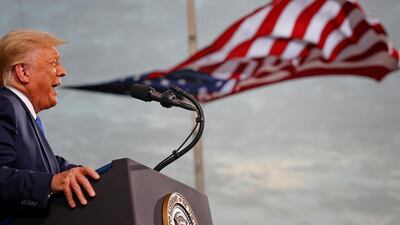The mob of Trump supporters that stormed the US Capitol on Wednesday was the culmination of weeks of agitation by President Donald Trump and his allies to overturn the results of the November 3 election.
Ever since major media outlets called the election for Democrat Joe Biden on November 7, Mr Trump, a Republican, mounted a campaign of legal challenges and online disinformation in a seemingly doomed effort to cling to power.
After the “Save America” rally in Washington and Trump supporters rampaging through the US Capitol this week, Mr Trump said he would hand over power to Mr Biden on January 20 — but repeated false claims of widespread fraud in last year’s vote.
“Even though I totally disagree with the outcome of the election, and the facts bear me out, nevertheless there will be an orderly transition on January 20th,” Mr Trump said in a statement posted on Twitter by his spokesman, Dan Scavino.
Mr Trump has spent the past two months refusing to concede the election and making spurious claims of mass voter fraud that have been rejected by dozens of courts and his Republican colleagues, including his former attorney general William Barr.
Before the election was called for Mr Biden and as votes were still being counted, Mr Trump began advancing claims of voting irregularities in Pennsylvania, Georgia and other tossup states.
On November 6, he said Mr Biden “should not wrongfully claim the office of the President and warned that “Legal proceedings are just now beginning!” The following day, he falsely claimed he “WON THIS ELECTION, BY A LOT!”
The president’s campaign lawyers filed suits challenging the counts in Arizona, Pennsylvania, Nevada, Georgia and Wisconsin hoping to stop officials from certifying election results, almost none of which gained traction in US courts.
That same day, Mr Trump's lawyer Rudy Giuliani briefed journalists in a car park outside a landscaping firm in Pennsylvania, offering no hard evidence of the voting fraud he alleged.
As weeks passed, Mr Trump’s legal challenges were repeatedly rejected by judges and election officials. After Georgia recertified its results and a win for Mr Biden on December 7, election officials in the Southern state said Mr Trump “has to stop” his rhetoric on voting fraud.
As Mr Biden was naming Cabinet picks, Mr Trump on November 26 for the first time acknowledged he would “certainly” leave the White House if his opponent’s win was endorsed by the Electoral College. Still, in a testy exchange with journalists, he continued making baseless claims of electoral fraud.
Since then, Mr Trump has faced a series of setbacks, from attorney general Mr Barr on December 1 declaring he had seen no evidence of widespread voting fraud, to the Electoral College’s certification of Mr Biden’s win on December 14.
By the time Congress was on Wednesday set to endorse the election results, Mr Trump's Republican loyalists were only able to make stonewalling gestures about voter fraud. The President knew this — and so did his supporters who were massed nearby at the rally.
































